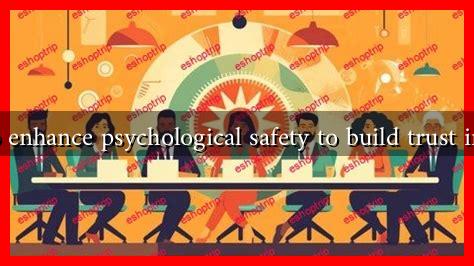-
Table of Contents
- How to Enhance Psychological Safety to Build Trust in Teams
- Understanding Psychological Safety
- Strategies to Enhance Psychological Safety
- 1. Foster Open Communication
- 2. Model Vulnerability
- 3. Encourage Risk-Taking and Innovation
- 4. Provide Constructive Feedback
- Case Studies and Statistics
- Conclusion
How to Enhance Psychological Safety to Build Trust in Teams
In today’s fast-paced and ever-evolving work environment, fostering a culture of psychological safety is essential for building trust within teams. Psychological safety refers to a shared belief that the team is safe for interpersonal risk-taking. When team members feel safe to express their thoughts, ideas, and concerns without fear of negative consequences, it leads to increased collaboration, innovation, and overall team performance. This article explores effective strategies to enhance psychological safety and build trust in teams.
Understanding Psychological Safety
Psychological safety was popularized by Amy Edmondson, a Harvard Business School professor, who defined it as a climate in which individuals feel comfortable being themselves. In a psychologically safe environment, team members are more likely to:
- Share ideas and feedback openly
- Admit mistakes without fear of retribution
- Engage in constructive conflict
- Take risks and innovate
Research shows that teams with high psychological safety are more effective. A study by Google, known as Project Aristotle, found that psychological safety was the most important factor in building successful teams. This highlights the need for leaders to prioritize creating a safe environment for their teams.
Strategies to Enhance Psychological Safety
Here are several actionable strategies that leaders can implement to enhance psychological safety and build trust within their teams:
1. Foster Open Communication
Encouraging open communication is vital for psychological safety. Leaders should create an environment where team members feel comfortable sharing their thoughts and opinions. This can be achieved by:
- Holding regular one-on-one meetings to discuss concerns and ideas.
- Implementing anonymous feedback tools to allow team members to voice their opinions without fear.
- Encouraging active listening during team discussions.
2. Model Vulnerability
Leaders should model vulnerability by sharing their own mistakes and uncertainties. This sets a precedent for team members to do the same. When leaders admit their shortcomings, it humanizes them and fosters a culture of openness. For example, Satya Nadella, CEO of Microsoft, openly discussed his learning journey and mistakes, which helped transform the company’s culture into one that values growth and learning.
3. Encourage Risk-Taking and Innovation
To build trust, teams must feel empowered to take risks. Leaders can encourage this by:
- Recognizing and rewarding innovative ideas, even if they fail.
- Creating a safe space for brainstorming sessions where all ideas are welcomed.
- Implementing a “fail fast” approach that encourages experimentation.
4. Provide Constructive Feedback
Feedback is essential for growth, but it must be delivered in a constructive manner. Leaders should focus on:
- Providing specific, actionable feedback rather than vague criticism.
- Encouraging peer-to-peer feedback to foster a culture of continuous improvement.
- Creating a feedback loop where team members can share their thoughts on the feedback process itself.
Case Studies and Statistics
Several organizations have successfully enhanced psychological safety and built trust within their teams. For instance, Google’s Project Aristotle revealed that teams with high psychological safety were more likely to achieve their goals and innovate. Additionally, a study published in the Journal of Applied Psychology found that teams with high psychological safety reported 26% higher performance than those with low psychological safety.
Another example is the healthcare sector, where organizations like the Virginia Mason Medical Center implemented a culture of safety that encouraged staff to report errors without fear. This led to significant improvements in patient care and operational efficiency.
Conclusion
Enhancing psychological safety is crucial for building trust within teams. By fostering open communication, modeling vulnerability, encouraging risk-taking, and providing constructive feedback, leaders can create an environment where team members feel safe to express themselves. The benefits of such an environment are clear: increased collaboration, innovation, and overall team performance. As organizations continue to navigate the complexities of the modern workplace, prioritizing psychological safety will be key to achieving long-term success.
For further reading on psychological safety and its impact on team dynamics, consider exploring resources from the Harvard Business Review.

